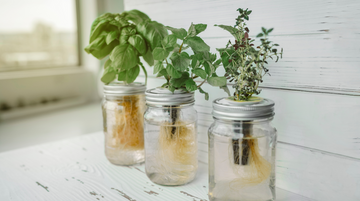At KitchenWorld24, we understand that having fresh herbs at your fingertips can elevate your culinary creations and enhance your meals with vibrant flavors. However, not everyone has the space or conditions for a traditional garden. That’s where hydroponics growing systems come in—a revolutionary way to cultivate fresh herbs at home, regardless of space or climate. In this comprehensive guide, we’ll walk you through everything you need to know about setting up and maintaining a hydroponics growing system, with a special focus on growing culinary herbs.
What is Hydroponics?
Hydroponics is a method of growing plants without soil, using nutrient-rich water to deliver essential nutrients directly to the plant roots. This system allows for faster growth, higher yields, and the ability to grow plants in smaller spaces, making it ideal for indoor gardening.
Benefits of Hydroponic Herb Gardening
-
Space Efficiency: Hydroponic systems can be set up indoors, making them perfect for apartments and homes with limited outdoor space.
-
Faster Growth: Plants grow faster in a hydroponic system because they have direct access to nutrients and water.
-
Year-Round Harvest: Indoor hydroponic systems are not affected by weather, allowing you to grow fresh herbs all year round.
- Pesticide-Free: Growing herbs in a controlled environment reduces the need for pesticides, ensuring your produce is safe and healthy.
Setting Up Your Hydroponics Growing System
-
Choosing the Right System: Several types of hydroponic systems are available, but for beginners, a simple Deep Water Culture (DWC) or Nutrient Film Technique (NFT) system is ideal due to their ease of setup and maintenance.
-
Selecting Your Location: Find a well-lit area in your home, such as a kitchen countertop or a windowsill. If natural light is limited, consider using grow lights to ensure your herbs receive enough light for optimal growth.
-
Gathering Your Materials:
- Hydroponic System Kit: Many kits come with everything you need, including a reservoir, air pump, grow tray, and net pots.
- Growing Medium: Materials like clay pellets, rock wool, or coconut coir provide support for your plants in the net pots.
- Nutrient Solution: Purchase a hydroponic nutrient solution formulated for herbs.
- pH Testing Kit: Maintaining the correct pH level (typically between 5.5 and 6.5) is crucial for nutrient absorption.
-
Herb Seeds or Seedlings: Popular culinary herbs for hydroponic systems include basil, mint, cilantro, parsley, and thyme.
-
Assembling the System:
- Set up your reservoir and fill it with water.
- Add the nutrient solution according to the manufacturer’s instructions.
- Place the air pump in the reservoir to oxygenate the water.
- Insert the net pots filled with the growing medium and herb seeds or seedlings into the grow tray.
- Position the grow lights above the system if natural light is insufficient.
Maintaining Your Hydroponics Growing System
-
Monitoring Water Levels and Nutrients: Regularly check the water level in the reservoir and top it up as needed. Refresh the nutrient solution every two to three weeks to ensure your plants receive adequate nutrition.
-
Maintaining pH Levels: Use your pH testing kit to monitor the water’s pH level. Adjust it with pH up or down solutions to keep it within the ideal range.
-
Providing Adequate Light: Ensure your herbs receive at least 12-16 hours of light daily. Adjust the height of grow lights as your plants grow to maintain an optimal distance from the light source.
-
Pruning and Harvesting: Regularly prune and harvest your herbs to encourage bushier growth and prevent overcrowding. Use clean scissors to avoid transmitting diseases.
-
Cleaning the System: Periodically clean the reservoir and other components to prevent algae buildup and keep your system functioning efficiently. Follow the manufacturer’s maintenance instructions for best results.
Troubleshooting Common Issues
-
Yellowing Leaves: This could indicate a nutrient deficiency. Check your nutrient solution and adjust accordingly.
-
Slow Growth: Ensure your plants are receiving enough light and that the pH and nutrient levels are within the optimal range.
-
Root Rot: Caused by overwatering or poor oxygenation. Ensure your air pump is working correctly and avoid waterlogging the roots.
Best Culinary Herbs to Grow Hydroponically
-
Basil: A fast-growing herb that is perfect for hydroponic systems. It’s versatile and can be used in a variety of dishes.
-
Mint: Thrives in a hydroponic environment and adds a fresh, aromatic touch to both sweet and savory recipes.
-
Cilantro: Requires cool conditions and ample light, making it ideal for indoor growing.
-
Parsley: Grows well in hydroponic systems and is a staple in many cuisines.
-
Thyme: A hardy herb that flourishes in hydroponic systems with minimal maintenance.
Conclusion
Growing your own fresh herbs at home using a hydroponics system is an excellent way to enhance your culinary experience and ensure you have access to healthy, pesticide-free produce year-round. At KitchenWorld24, we are committed to providing products that support your healthy lifestyle, and our range of hydroponics growing systems is designed to help you cultivate a thriving indoor garden with ease.
Visit our store today to explore our selection of hydroponic systems and start your journey to fresh, home-grown herbs. Embrace the future of gardening with KitchenWorld24 and enjoy the benefits of fresh, flavorful herbs at your fingertips!




